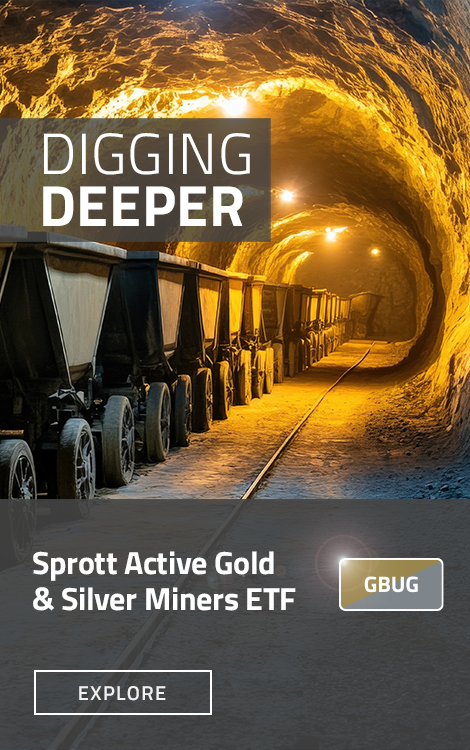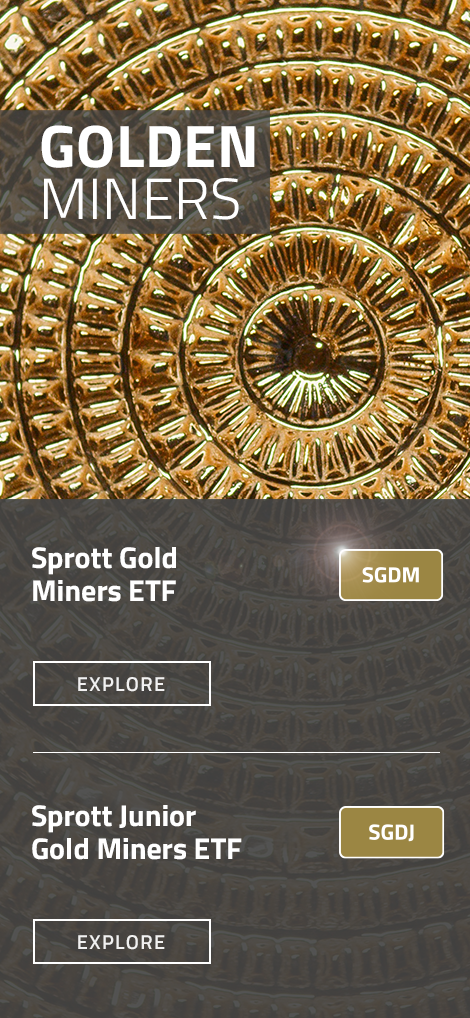Gold has recently climbed to record highs. In this episode of Metals in Motion, Steve Schoffstall, Director of ETF Product Management at Sprott, joins Thalia Hayden @etfguide to explain why gold is performing well, and why the gold mining trade might still have room for investors to make their move.
For the latest standardized performance and holdings of Sprott Precious Metals ETFs, please visit the individual website pages: GBUG, SGDM, SGDJ and SLVR. Past performance is no guarantee of future results.
Video Transcript
Thalia Hayden: You are watching Metals in Motion. I'm Thalia Hayden with ETFguide. We're glad to see you again. We are in the middle of autumn, and the leaves aren't the only things turning gold; many investor portfolios are also. To help understand the growing importance of gold, we're talking with Steve Schoffstall, Director of ETF Product Management at Sprott Asset Management. Steve, welcome to the program. It's so great to see you again.
Steven Schoffstall: It's great to be back. Thank you.
Thalia Hayden: Please describe the primary drivers behind gold's recent price surge to record highs. Do you believe these factors will remain in place going forward?
Steven Schoffstall: It’s the same story you’d expect from gold. Gold tends to perform well during periods of economic or geopolitical uncertainty. Factors such as falling interest rates and central bank buying have been bullish for gold, pushing prices higher—especially as countries shift away from the U.S. dollar during a period of de-dollarization. These factors have been driving gold prices higher. When you look at the yield curve, you’re seeing a steepening—an indication that investors are losing faith in central banks. That’s a positive sign for higher gold prices going forward.
Thalia Hayden: Got it. Gold miners have historically delivered strong returns during gold bull markets. How have mining equities performed relative to physical gold?
Steven Schoffstall: If we were having this conversation a year ago, we'd be talking about the gold miners being poised to have a catch-up trade to the price of gold. A lot has changed this year, where we're now seeing gold miners dominating ETF performance tables. Looking at the top-performing ETFs, 12 out of 13 best performers are gold or silver miners.
When you look at it on a performance basis and compare the performance of gold versus the miners, a broad-based benchmark like the NYSE Arca Gold Miners Index, a widely followed miners index, has returned about 130% this year. In contrast, physical gold is up about 52%.
This outperformance among miners occurs even as we see outflows from gold mining ETFs. Year to date, about $4.1 billion has left gold mining ETFs, while global physically-backed gold funds have added roughly 14 million ounces of gold to their storage.
Thalia Hayden: Wow. Some investors may look at gold's recent performance and worry they've missed the opportunity. What would you say to those hesitant to enter the gold mining sector at current levels?
Steven Schoffstall: Gold miners stack up quite favorably to the S&P 500. Gold miners tend to have about an 86% greater profit margin, less leverage and less debt on the books, a dividend yield that's about 40% higher than the S&P 500, which is also going through a period where it seems to be setting records on a very frequent basis.
The lack of significant flows into gold mining ETFs suggests the trade isn’t overcrowded. We haven’t seen substantial inflows over the past 18 months.
Before last December, mining stocks were trading in strong consolidation patterns. This attracted deep-value contrarian investors, who aren’t mainstream and don’t represent the majority of investors.
In our view, gold miners are returning to vogue as their balance sheets improve with higher gold prices. They're operating much differently than they were in the past bull market.
Thalia Hayden: That's good to know. Sprott offers three distinct gold mining ETFs: GBUG, SGDM and SGDJ. Can you walk us through how the strategies differ between these funds and what makes each one unique?
Steven Schoffstall: GBUG, Sprott Active Gold & Silver Miners ETF, is our active strategy. It's the fund we launched back in February. Assets are already up to about $120 million. It's the only actively managed gold ETF in the U.S. It leverages our portfolio management team’s century-plus of expertise and gives them the flexibility to manage across market caps, from small development exploration companies to the largest gold miners.
Then we have SGDM, Sprott Gold Miners ETF. This is a passively managed ETF that tracks a selective index. It's a factor-based index, not just a pure market-cap-weighted index. The larger companies are ranked based on revenue growth, long-term debt-to-equity ratio and free cash flow yield.
Our Junior Miners version, SGDJ, is also based on a factor-based index. This index will look at smaller junior exploration and development companies. The smaller explorers will be ranked based on price momentum, whereas the smaller producers will be ranked based on revenue growth.
Offering both passive and active strategies gives investors a choice to determine what best suits their investment objectives.
Thalia Hayden: You recently launched GBUG, your active gold and silver miners ETF. What gap in the market does this fund fill, and how does the active management approach add value for investors?
Steven Schoffstall: It comes down to our portfolio management team’s century of experience. We don’t see that in other gold miner ETFs, since this is the only active strategy. The investment team conducts over 200 management meetings per year, providing them with the opportunity to delve into and understand the management of each company.
Additionally, they're also getting boots on the ground with up to 30 site visits per year. I know some of our PMs are out on the road now visiting mine sites as we record this. These mine site visits enable them to gain a comprehensive understanding of the mine and interact with all levels of employees and management within the organization, thereby gaining a full grasp of the overarching picture and how each individual mine site is being operated.
This becomes particularly helpful when examining the makeup of our portfolio management team. One of our senior PMs on the Fund spent two decades working as an economic geologist, where he would work for mining and exploration companies and lead teams across the globe as they were looking for new mine sites.
The team’s collective experience enables them to assess both operational aspects and proprietary valuation models, bringing the whole picture together through sensitivity analysis.
One last point: the mining sector is notoriously difficult to value due to operational complexities. Our expertise and frequent site visits allow us to investigate miners and seek outperformance, which often results in a wide dispersion between top and bottom performers.
Thalia Hayden: Regarding gold mining exposure, Steve, what should investors consider when deciding between an active strategy like GBUG versus passive strategies like SGDM or SGDJ?
Steven Schoffstall: The first thing to note is that there's no right or wrong answer. A lot of it comes down to investor preference. Some investors prefer not to take on active manager risk, and that's entirely understandable. In contrast, some investors may prefer active management and seek the extra alpha that an active strategy can generate.
When developing our lineup, we wanted to give investors a choice. GBUG is well-positioned for those comfortable with active manager risk. For investors who prefer a passive approach, we offer two factor-based indexes that are also well-positioned.
Thalia Hayden: Beyond price momentum, what fundamental factors support the case for gold mining equities today, whether that's production metrics or sector dynamics?
Steven Schoffstall: These are components of our proprietary pricing models. Revenue growth, free cash flow, and operating costs are all important factors. However, management capability is one aspect you can’t always capture in models.
Looking back at the previous gold bull market in the early 2010s, this aspect changed around 2010, when gold prices were rising rapidly.
Previously, management teams aimed to increase output at any cost. Now, they’re much more measured in their approach to growth and are focused on returning capital to investors through share buybacks or increased dividends.
All of this puts gold miners in a position where we think they're much better able to not only bring in the capital but, much more importantly, spend it wisely and grow the business with a more measured approach.
Another aspect is the rising labor or energy costs over the last decade. These have allowed them to invest in new technology and methods, making their operations more efficient. These non-financial factors have become so important to the gold miner space.
Thalia Hayden: Steve, one final question before we let you go. What about gold mining ETFs fitting into a broader portfolio strategy? How might they complement holdings in physical gold products like your PHYS Trust?
Steven Schoffstall: That's a great question, and one we get often. We believe a core allocation of 5 to 15% physical gold is probably reasonable for most investors.
Gold miners can enhance this by providing leveraged returns to the price of gold, as they have operational leverage. Because of this, some investors can use miners to either increase or decrease their gold exposure, so in periods of bull markets, investors might add to their mining exposure.
Investors should remember that mining stocks are different from physical gold. You do start to introduce some equity risk in your portfolio, and that should be viewed in the overall context of the portfolio.
Thalia Hayden: Steve, thank you so much for your timely insights. We always learn so much after speaking with you. Keep up the great work, and we look forward to seeing you soon.
Steven Schoffstall: Looking forward to it. Thank you.
Thalia Hayden: If you would like more information on what we've discussed today, you can always visit sprottetfs.com. That does it for this episode of Metals in Motion. If you enjoyed the show, please tell us in the comments section below. Hit that like button. Also, check out our Season 2 playlist to watch this year's archived episodes. It's located in the description section below. I'm Thalia Hayden with ETFguide. Thanks for watching. We'll see you next time.
Important Disclosures
An investor should consider the investment objectives, risks, charges and expenses of each fund carefully before investing. To obtain a fund’s Prospectus, which contains this and other information, contact your financial professional, call 1.888.622.1813 or visit SprottETFs.com. Read the Prospectus carefully before investing.
Exchange Traded Funds (ETFs) are considered to have continuous liquidity because they allow for an individual to trade throughout the day, which may indicate higher transaction costs and result in higher taxes when fund shares are held in a taxable account.
The funds are non-diversified and can invest a greater portion of assets in securities of individual issuers, particularly those in the natural resources and/or precious metals industry, which may experience greater price volatility. Relative to other sectors, natural resources and precious metals investments have higher headline risk and are more sensitive to changes in economic data, political or regulatory events, and underlying commodity price fluctuations. Risks related to extraction, storage and liquidity should also be considered.
Shares are not individually redeemable. Investors buy and sell shares of the funds on a secondary market. Only “authorized participants” may trade directly with the fund, typically in blocks of 10,000 shares.
The Sprott Active Metals & Miners ETF, Sprott Active Gold & Silver Miners ETF and the Sprott Silver Miners & Physical Silver ETF are new and have limited operating history.
Sprott Asset Management USA, Inc. is the Investment Adviser to the Sprott ETFs. ALPS Distributors, Inc. is the Distributor for the Sprott ETFs and is a registered broker-dealer and FINRA Member. ALPS Distributors, Inc. is not affiliated with Sprott Asset Management USA, Inc.



